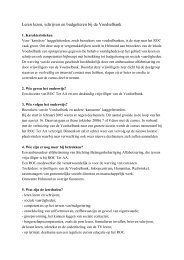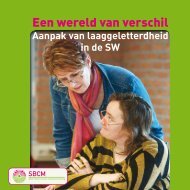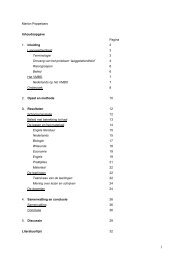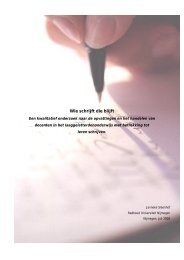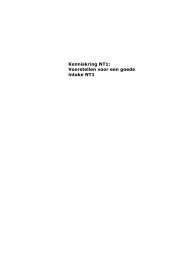Laaggeletterden leren lezen - website Basisvaardigheden
Laaggeletterden leren lezen - website Basisvaardigheden
Laaggeletterden leren lezen - website Basisvaardigheden
You also want an ePaper? Increase the reach of your titles
YUMPU automatically turns print PDFs into web optimized ePapers that Google loves.
<strong>Laaggeletterden</strong> <strong>leren</strong> <strong>lezen</strong><br />
Marieke Hanekamp<br />
The child should learn the left-to-right principle, but initially only as it applies to complete words in<br />
continuous text;<br />
The child should learn patterns of correspondence between letters and sounds, to help him<br />
recognize words that he already knows in his spoken language or help him determine the<br />
pronunciation of unfamiliar words;<br />
The child should learn to recognize printed words from whatever cues he can use, but initially only<br />
from total configurations;<br />
The child should learn that printed words are signals for spoken words and that meanings can be<br />
apprehended from these printed words;<br />
The child must learn to reason and think about what he reads.’<br />
Discussies over de wijze waarop het leesonderwijs ingericht zou moeten worden zijn eigenlijk<br />
discussies over de volgorde waarin bovenstaande deelvaardigheden aangeleerd zouden moeten<br />
worden. Wanneer een kind moeilijkheden heeft met <strong>lezen</strong> is het van groot belang om erachter te<br />
komen welke van de bovenstaande deelvaardigheden deze moeilijkheden veroorzaken. Pas dan kan er<br />
gericht actie worden ondernomen zodat het kind vooruitgang kan boeken.<br />
De manier waarop een docent tegen het <strong>leren</strong> <strong>lezen</strong> aankijkt bepaalt in hoge mate de manier<br />
waarop hij onderwijst. Chapman en Czerniewska (1978, p.65-66) onderscheiden vijf manieren waarop<br />
docenten tegen de vaardigheid <strong>lezen</strong> aan kunnen kijken en de wijze waarop dit hun handelen in de<br />
klas beïnvloedt: ‘If he [d.w.z. een docent; M.H.] thinks of reading primarily as a visual task, he will be<br />
concerned with the correlation of visual defects and the provisions of legible reading material. If<br />
reading to him is word recognition, he will drill on the basic sight vocabulary and word recognition<br />
skills. If he thinks reading is merely reproducing what the author says, he will direct the student’s<br />
attention to the literal meaning of the passage an check his comprehension of it. If he views reading<br />
as a thinking process, he will be concerned with the reader’s skill in making interpretations and<br />
generalizations, in drawing inferences and conclusions. If he thinks of reading as contributing to<br />
personal development and social welfare, he will provide his students with reading material that will<br />
help them develop sound values and that will have some application to their lives and to the modern<br />
world’.<br />
2.3.2 Bottom-up, top-down en interactief.<br />
Bepaalde aspecten in het leesproces zijn tot op heden een raadsel. Volgens Carrrol (1978; in<br />
Chapman & Czerniewska, 1978, p.96) is ‘the actual process by which we recognize words not well<br />
understood, simply because the whole process of ‘pattern perception’, as it is called, is one of the<br />
most mysterious problems in psychology’. Van den Berg en Middel (1992) beschrijven drie modellen<br />
die verklaren hoe een tekst ge<strong>lezen</strong> wordt: het bottom-upmodel, het top-downmodel en het<br />
interactieve model.<br />
Het bottom-upmodel gaat ervan uit dat een lezer betekenis geeft aan een tekst door de<br />
lettertekens om te zetten in klanken. De klanken vormen een woord, de woorden vormen een zin en<br />
de zinnen vormen gezamenlijk een tekst. Deze processen vinden na elkaar plaats, waarbij er geen<br />
26


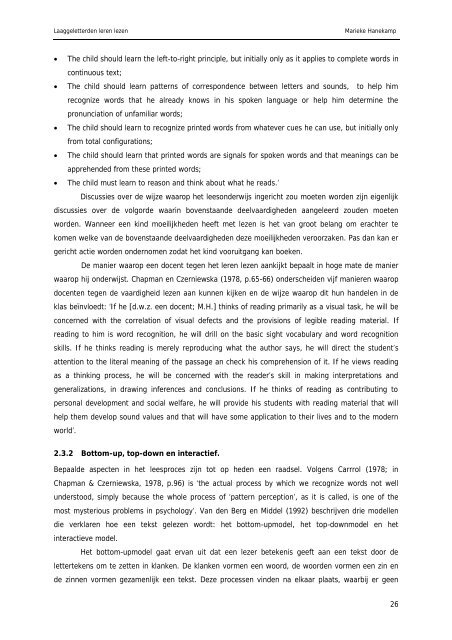
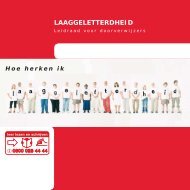

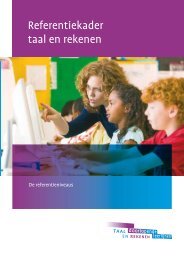
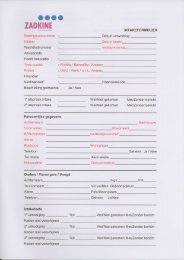
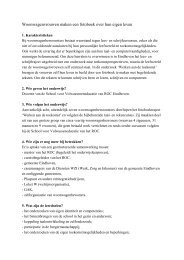
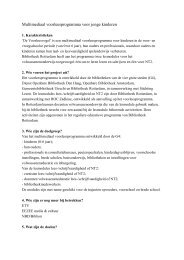
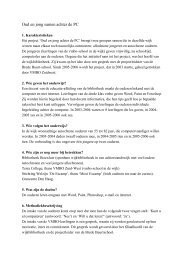
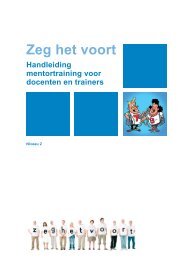
![Presentatie Laaggeletterdheid SITA [Compatibiliteitsmodus]](https://img.yumpu.com/42777629/1/190x135/presentatie-laaggeletterdheid-sita-compatibiliteitsmodus.jpg?quality=85)
